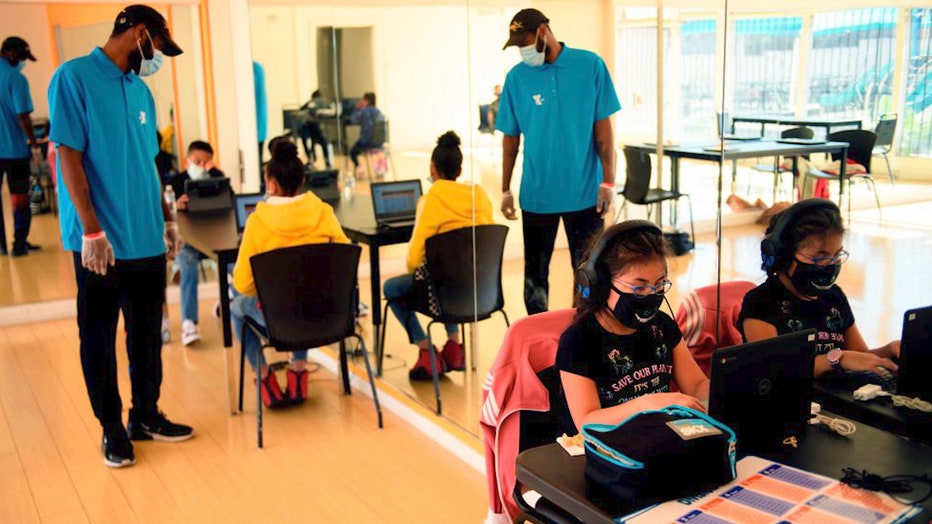83% of Michigan school districts now offer in-person learning
LANSING, Mich. - More than 80% of Michigan school districts planned to offer some form of in-person instruction in February, which represented a more than 20 percentage-point increase over the previous month amid a decline in the coronavirus' spread.

FILE - A YMCA staff member assists a child as they attend online classes at a learning hub inside the Crenshaw Family YMCA during the COVID-19 pandemic on Feb. 17, 2021 in Los Angeles, California.
Michigan State University's Education Policy Innovation Collaborative said it was the largest monthly increase since the start of the academic year. Gov. Gretchen Whitmer has strongly encouraged schools to offer a face-to-face option by March 1.
Researchers released a report showing that 83% of traditional districts and charter schools planned to do so this month, with 65% offering a fully in-person option and 18% offering hybrid instruction. Just 15% of districts planned to be fully remote, down from 35% in January.
Districts' pandemic learning plans can be fluid and change after they are submitted each month to EPIC, the state Department of Education's strategic research partner.
The Democratic governor called the trend, which coincides with the vaccination of teachers, "encouraging."
"With proper mitigation strategies, we can send kids back to class without compromising the health of our communities," said Whitmer, whose administration in mid-November prohibited face-to-face instruction in high schools for a month to curb spiking COVID-19 cases and save lives.
About 65% of districts planned to offer full in-person schooling in February. They have 55% of the state's public K-12 students, a reflection of the fact that districts with the option tend to be smaller than the state average. Many students in districts with a full face-to-face option are choosing a hybrid or remote-only model, according to the survey, which said districts planned to provide full in-person instruction to 31% to 45% of students across Michigan.
"These data suggest that the Biden and Whitmer administrations’ efforts have encouraged districts to return to in-person learning. However, there remain troubling discrepancies for some of the most vulnerable students," said MSU education professor Katharine Strunk.
By law, K-12 districts and charter schools have discretion over whether to allow in-person classes this school year and, if they deem it as safe, must prioritize the option for K-5 students. The percentage of districts and charter schools with a planned face-to-face option in February is similar to the ratio in October and November — before COVID-19's resurgence.
A Republican-led Senate committee on Tuesday heard testimony from parents and others about school closures. Some large districts, such as Ann Arbor and Kalamazoo, remain fully virtual despite the governor's recommendation and may not offer face-to-face classes until the next academic year.
University of Michigan law professor Nicholas Bagley said his two children, who are in seventh and fifth grade, have not been to school in person for almost a year and that online learning is "not working for them" in terms of learning loss or their mental health. He said he has "no confidence" that the Ann Arbor Public Schools Board of Education will authorize five days a week of in-person instruction in the fall.
Bagley said Washtenaw County's vaccination rate for teachers is low and he asked lawmakers for help on that front. The district has not given a clear date for restarting school for special education or elementary students, he said.
He urged lawmakers to not give local boards "anything close to the same latitude" for the 2021-22 academic year. He proposed that schools be required to provide five days of full in-person learning a week and that students not "stare at a screen while they're in a classroom." Only students who opt out of face-to-face teaching should be forced to go virtually, he said.
GOP legislators and Whitmer are at odds over disbursing billions of dollars in federal pandemic funding, including for schools. The House has voted to release K-12 funds only if the governor signs legislation giving local health departments — not the state health department — the power to close schools and prohibit sports. She has said there should be no strings attached to the aid and has vowed not to weaken her administration's powers.

